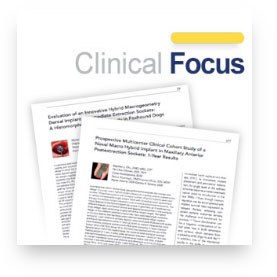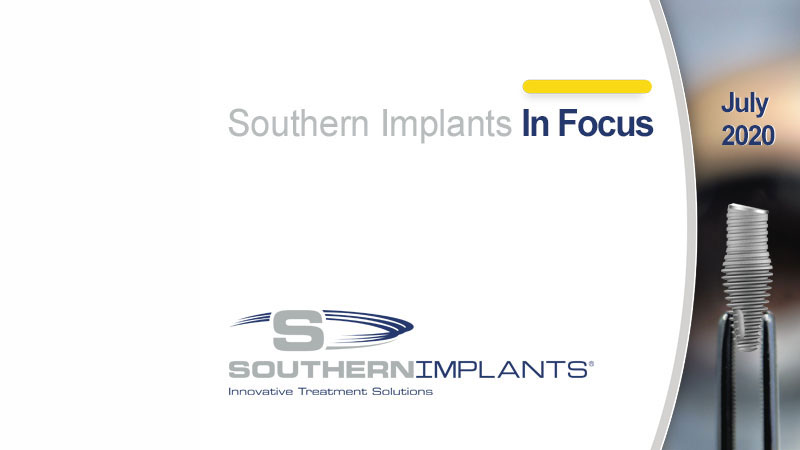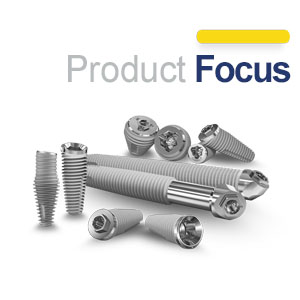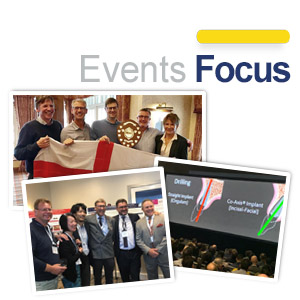Table of Contents
Graham Blackbeard,
Founder and Managing Director
Message from Graham
Welcome to the July issue of “Southern Implants In Focus”
A number of our customers around the world are opening their practices and businesses again and preparing for dental implant procedures in the new environment. Requirements for Personal Protective Equipment (PPE) and refined standard operating procedures focused on increased safety are revised and updated the world over.
Our concern is for your safety and that of your staff and patients. In this regard we are working as fast as we can on three PPE projects. One is a FFP1 face shield with filtered air down-flow, the other is a FFP3 mask and thirdly we have started testing a headgear wearable “source” that kills viruses and bacteria while the dentist is working.
The Regulatory authorities for Europe, USA and Canada have fortunately been hard at work. We received notice from the FDA that our ZAGA™ Implants (which we designed and manufactured in a collaborative project for Straumann®) have been cleared for use in the USA. This is approximately 6 months ahead of schedule, which has delighted our client. The Straumann Group has announced the new zygomatic implant solution that it will bring to market in collaboration with Southern Implants.
The current Medical Device Regulation for Europe is the MDD (Medical Device Directive). This is being replaced with the MDR (Medical Device Regulation). Firms can convert to the new law between now and 2025. We know our house is in order and decided to do this conversion in 2020, to be one of the first firms to achieve MDR compliance. This “quiet time” caused by COVID-19 Restrictions has helped Lauranda Breytenbach, who leads Southern’s Regulatory Department, and her team make steady progress in this regard.
Due to the ongoing COVID-19 Pandemic it appears that tourism and international travel will remain challenging for at least the rest of 2020 and into 2021. It is with this in mind that we decided to cancel our International Forum for 2020 and move it out to 20-23 March 2022.
We don’t know exactly what the rest of this year holds, but we will be doing all we can to facilitate support with your implant treatments. Please feel free to give me a call or a WhatsApp message if you want more detail on what’s happening at the coalface.
Accelerated Treatment Time Using Southern Implants Innovative Products
P.O. Östman, DDS, PhD, MD
Prosthetic rehabilitation of the edentulous patient with implant supported bridges is a viable and predictable treatment option. Long-term studies have reported high clinical success rates with the original protocols, giving clinicians confidence to further develop and refine techniques. Today, dental implants are used in more challenging situations and for a wider range of indications. We’ve progressed from traditional protocols using implants only in the intra-foramen area in the mandible to placing single implants in grafted bone in the posterior Maxilla with success.
A similar trend is now recognized for timing of implant loading. A submerged healing period of 3-6 months was originally considered a prerequisite for achieving osseointegration of titanium implants. During the last 20 to 25 years this traditional protocol has been challenged and numerous clinical studies have reported on the successful outcome of early and immediate loading in various clinical situations. There has also been a change of focus of the treatment from originally being a strict functional rehabilitation to a treatment modality with great attention on aesthetics.1
Shorter treatment times are increasingly important in modern implant dentistry, and from the patient’s point of view, there is a definite interest in reducing the time between implant placement and having a functional, aesthetic prosthesis in place. Shorter treatment time further poses economic benefit with less impact on restricting the professional and social lives of busy patients. It can be speculated that from the clinician’s point of view, saving chair time also has an impact on the cost to the clinician. (Watch Dr. Nicholas Egbert’s webinar on this subject here).
A comparative study2 whereby patients received either a single implant within 10 days after tooth extraction or after 4 months, assessed the patients’ subjective opinion of surgical and prosthetic treatment. Assessment of the implant surgery was not significantly different between groups but evaluating satisfaction with the overall implant treatment showed the patient’s appreciation was significantly higher for the group treated faster. One could argue that the aspect of time management should not be decisive in choosing the treatment protocol. On the other hand, the belief that the patient has no choice no longer holds true.
Patients now have higher expectations concerning chewing comfort and prosthetic outcome compared to the early era of implant dentistry3 and patients’ attitude and satisfaction with prosthetic restorations are influenced by the current trends in adult dental health.
A few papers evaluated patients’ satisfaction with implant treatment after immediate loading treatment. Attard, et al5 evaluated patients treated with implant-retained mandibular overdentures and demonstrated a significant improvement of the oral health status, compared with the previous conventional denture. Erkapers, et al6 evaluated satisfaction with immediately loaded cross arch bridges in the maxilla in 51 patients. They presented a significant improvement in satisfaction related to functional limitation, physical pain, psychologic discomfort, physical disability and psychologic disability using the Oral Health Impact Profile 49 (OHIP-49) questionnaire. Dierens, et al.7 assessed the subjective opinion of patients treated with immediate loading in total edentulous maxillae and mandibles. 25 subjects in each group answered self-administered questionnaires on a visual analogue scale or with multiple-choice or open questions at baseline, 1 week, 3 or 6 months and 1 year.
These studies showed that the main reason patients gave for choosing fixed prosthetics was eating comfort. Phonetics and aesthetics were more important in the maxilla than in the mandible. Overall comfort, eating comfort, speaking comfort and perceived aesthetics improved significantly within 1 week after surgery and immediate provisionalization. This did not change significantly until the definitive restoration was installed after 3 (mandible) or 6 months (maxilla), when a further significant improvement was demonstrated. The importance of one-stage surgery and immediate loading was rated very high by patients before treatment, especially in the mandible.
For the last 20 years Southern Implants has developed many products and protocols that overcome challenging clinical scenarios and provide the best treatments possible. These innovations assist in the provision of accelerated treatments, where patients can be treated with fewer visits and procedures:
- Implant Microgeometry for Good Primary Stability: Southern Implants has developed implant macro-geometry designs, as well as drills and drill protocols, designed to achieve high primary stability. These products and protocols have increased the success of implant therapy in challenging situations, such as immediate loading. Implants with high initial primary stability seem to function well when immediately loaded.
- SIDigital for Effecient Prosthetic Workflows: The Southern Implants digital workflow enables fast and predictable delivery of temporary and definitive prosthetics. Southern’s digital solutions provide digital tools that accurately facilitate the digital workflow between the dentist and laboratory for CAD/CAM procedures.
- Site-Specific Implants: Designed for accelerated loading protocols, Implants such as MAX for post extraction replacement in a molar socket, INVERTA® for optimizing aesthetics in anterior extraction sites, and other site-specific implants that may allow the clinician to avoid grafting in the atrophic maxilla, such as Nazalus, Zygomatic Implants (Zygan™) and up to 36 degree Co-Axis® Subcrestal Angle Correction® Implants.
- SInergy Surface for Predictable Osseointegration: The Southern Enhanced Surface, SInergy, in clinical use since 1997, has never been altered. It is an abraded, medium rough surface providing stable titanium oxides equal to the dense form of titanium oxide common with turned surface implants. The particle size of 110µm was set based on research showing the greatest bone to titanium bond strength is obtained with abrasion particles greater than 75µm and less than 170µm. The Southern Surface has an avarage Sa of 1.5mm. One RCT and two retrospective studies have shown successful outcomes for the Southern surface with over 15 years follow-up. The surface enhances a contact osseogenesis, enabling a faster bonelock compared to non-modified surfaces.
How can implant design facilitate the achievement of aesthetic outcomes?

Bone quality needs to be evaluated, such as with soft bone. Reducing the final drill diameter for the osteotomy to enhance primary implant stability may provide more predicable outcomes. A final torque exceeding 35 Ncm and an ISQ value above 65 Ncm seems to be sufficient objective values for immediate loading. Splinting the prosthesis, (chair-side or laboratory made) is important to obtain high success rate.
An immediate loading approach in combination with Southern Implants digital tools often leads to faster and more predictable treatment outcomes that save the clinician time and money … and most important, increases patient satisfaction.
1. Immediate loading in partially and completely edentulous jaws: a review of the literature with clinical guidelines.
De Bruyn H, Raes S, Ostman PO, Cosyn J.Periodontol 2000. 2014 Oct;66(1):153-87. doi: 10.1111/prd.12040.
2. Patient experience of, and satisfaction with, delayed-immediate vs. delayed single-tooth implant placement.
Schropp L, Isidor F, Kostopoulos L, Wenzel A.Clin Oral Implants Res. 2004 Aug;15(4):498-503. doi: 10.1111/j.1600-0501.2004.01033.x.
3. What are the prevalence and incidence of tooth loss in the adult and elderly population in Europe?
Müller F, Naharro M, Carlsson GE.Clin Oral Implants Res. 2007 Jun;18 Suppl 3:2-14. doi: 10.1111/j.1600-0501.2007.01459.x
4. A longitudinal study of quality of life outcomes in older adults requesting implant prostheses and complete removable dentures.
Allen PF, McMillan AS.Clin Oral Implants Res. 2003 Apr;14(2):173-9. doi: 10.1034/j.1600-0501.2003.140206.x.
5. A prospective study on immediate loading of implants with mandibular overdentures: patient-mediated and economic outcomes.
Attard NJ, Laporte A, Locker D, Zarb GA.Int J Prosthodont. 2006 Jan-Feb;19(1):67-73
6. Patient satisfaction following dental implant treatment with immediate loading in the edentulous atrophic maxilla.
Erkapers M, Ekstrand K, Baer RA, Toljanic JA, Thor A.Int J Oral Maxillofac Implants. 2011 Mar-Apr;26(2):356-64
7. Patient-centered outcome of immediately loaded implants in the rehabilitation of fully edentulous jaws.
Dierens M, Collaert B, Deschepper E, Browaeys H, Klinge B, De Bruyn H.Clin Oral Implants Res. 2009 Oct;20(10):1070-7. doi: 10.1111/j.1600-0501.2009.01741.x. Epub 2009 Aug 30
 Research – The Core of Product Development
Research – The Core of Product Development
Conventional drills vs piezoelectric surgery preparation for placement of four immediately loaded zygomatic oncology implants in edentulous maxillae: 3-year results of a within-person randomised controlled trial
Roberto Pistilli, MD; Marco Esposito, DDS, PhD, Carlo Barausse, DDS, PhD, Andrea Balericia, DDS, Lorenzo Bonifazi, Jacopo Buti, DDS, PhD, MPerio RCSEd, Pietro Felice, MD, DDS, PhD
The authors selected 20 edentulous patients with severely atrophic maxillae and insufficient bone volumes for placing dental implants (less than 4 mm of bone height subantrally). Their hemi-maxillae were randomised for implant site preparation with either conventional rotational drills or piezoelectric surgery. Two zygomatic oncology implants (unthreaded coronal portion) were placed in each hemi-maxilla. Implants that achieved an insertion torque of greater than 40 Ncm were immediately loaded with provisional screw-retained metal-reinforced acrylic prostheses. Outcome measures were: prosthesis and implant failures, any complications, time taken to place the implants, presence of post-operative haematoma, and patient preference, as assessed by blinded assessors when possible. All patients were followed up for 3 years after loading.
In two patients, drills had to be used in the piezoelectric surgery sites because piezoelectric preparation was insufficient. One implant from the conventional drill group did not achieve an insertion torque of greater than 40 Ncm since the zygoma fractured. Three patients dropped out. Two distal oncology implants failed in the same patient (one per group), who was not prosthetically rehabilitated. Six patients experienced at least one complication at drilled sites and five at piezoelectric surgery sites (three patients had bilateral complications), the difference not being statistically significant (odds ratio = 1.5; p [McNemar’s test] = 1.0; 95% CI of odds ratio: 0.25 to 8.98). Implant placement with conventional drills took on average 14.35±1.76 minutes vs. 23.50±2.26 minutes with piezoelectric surgery, the implant placement time being significantly shorter with conventional drilling (difference = 9.15±1.69 minutes; 95%CI: 8.36 to 9.94 minutes; p = 0.000). Post-operative haematomas were larger at drilled sites in 11 patients and similar at both sides in nine patients (chi-square = 20.4; df = 3; p = 0.0001), and 16 patients found both techniques equally acceptable while four preferred piezoelectric surgery (chi-square = 34.4; df = 3; p<0.0001).
The authors concluded that both drilling techniques achieved similar clinical outcomes. Conventional drilling was slightly faster, requiring nine minutes less. They also noted that these results may be system-dependent, and therefore cannot be generalised to other zygomatic systems with confidence.
Tapered versus inverted body-shift implants placed into anterior post-extraction sockets: A retrospective comparative study
Stephen J Chu, DMD, MSD, CDT; Jocelyn HP Tan-Chu, DDS; Hanae Saito, DDS, MS; Pär-Olov Östman, DDS, PhD; Barry P Levin, DMD; and Dennis . Tarnow, DDS
This retrospective comparative radiographic and clinical study was performed to evaluate primary stability, bone volume and aesthetic outcomes of regular tapered implants (control group) vs inverted body shift implants (test group).
A total of 42 platform-switched implants, 21 regular implants, and 21 inverted body shift implants were used to replace non-restorable teeth in maxillary central incisor post-extraction sockets. Implant primary stability and insertion torque values were measured in addition to radiographic differences in labial plate dimension and tooth to implant distance, and marginal bone levels were correlated with clinical outcomes using the Pink Esthetic Score (PES).
Statistically significant differences (p<0.05) were found. Regular implants not only had lower primary stability at immediate placement, but they also showed less circumferential bone volume at recall. Lower PES was seen in the regular implant group, equating to an increased frequency of midfacial recession, tissue discoloration and papilla loss.
The authors’ conclusion is that the inverted body shift implant may offer advantages over regular implants in maxillary anterior post-extraction sockets in achieving both higher primary stability and superior aesthetic outcomes.
Maxillary and mid-facial oncology defects: A review
Hackett, Stephanie; El-Wazani, Basma; Butterworth, Chris
This literature review reports the current evidence for the use of zygomatic implants in head and neck oncology patients for the prosthetic rehabilitation of defects of the mid-face and maxilla. MEDLINE, Embase and Cochrane databases were searched using strict search terms. Two independent reviewers reviewed the articles and applied inclusion and exclusion criteria.
Thirty-two articles were analysed after applying the inclusion criteria on the 437 articles found. Overall survival rates of 77%–100% were reported with few complications, although only four centres presented data on 20 or more patients. Primary implant placement at time of resective surgery has been shown to be an effective means of accelerating rehabilitation along with early loading protocols. It is clear that zygomatic implants can be successfully used in patients who were treated with radiotherapy. Providing support for maxillary obturators was the most common use reported with both splinted and unsplinted implants.
It was clear from the review that zygomatic implants provide remote anchorage for a variety of oral and facial prostheses that contribute to the improved function and quality of life for patients being treated for maxillary and mid-facial tumours.
Events Focus
Pivoting to the Southern Implants Virtual Connection Webinar Series
This Pandemic has turned the world upside down, challenging businesses and individuals to find innovative ways to thrive in their professional and personal lives.
The same holds true for Southern Implants. We identified early on that it was imperative to stay connected to our customers and provide value with that connection. We pivoted from a full plan of in-person education courses, trade meetings and our very own International Symposium to the Southern Implants Virtual Learning Connection (SIVLC).
The series of global online educational opportunities were presented by experienced, well-known speakers. The content was tailored to our clinician and business partners as a way for them to learn about innovative treatment solutions and how these can be used once we are able to open again. We are thrilled to report that hundreds of clinicians, labs and dental professionals tuned in to the live events. Below is a brief recap of the webinars. Nearly all can be viewed on-demand at https://southernimplants.com/on-demand-webinars/
The series kicked off with Drs. Guy McLellan, Riz Syed and Stavros Eleftherious in the UK whose webinar “Treatment options for the atrophic maxilla” highlighted different approaches that can be utilised in the treatment of the atrophic maxilla. Dr. Syed discussed the use of the Nazalus Implant, Dr. McLellan reviewed the Zygomatic Implant option and Dr. Eleftherious presented his success treating these cases utilising extreme bone grafting. It was a great opportunity to see these three clinicians, each with their own approach, on the same platform.
Graham Blackbeard, Southern Implants Founder and Manging Director, presented about the laser focus Southern has on precision engineering and quality manufacturing and how this focus results in providing clinicians innovative treatment solutions for optimal patient outcomes.
Bringing the series full circle, Dr. James Digges from Australia presented two webinars about digital prosthetic planning and design for single unit and Co-Axis® Subcrestal Angle Correction® cases.
Drs. Stephen Chu, Costa Nicolopoulos and Petros Yuvanolgu presented “New Trends in Modern Dentistry: Optimizing Aesthetics with the Body-Shift™ INVERTA® Implant”
In this webinar the three clinicians highlighted how immediate tooth replacement therapy has become a mainstream treatment modality for single and multiple tooth replacement in the aesthetic zone. The balance between achieving primary stability, implant diameter, and gap distance is a delicate dance yet essential for survival and aesthetics, as well as the existence of aesthetic risks and complications. An inverted body-shift implant design (INVERTA), as well as pre-clinical [animal histology] and clinical [human] studies were presented.
The COVID-19 Pandemic is proving to have impact on how we run our business, and certainly how clincians run their practices. Social distancing of patients, practice capacity regulations, deep cleaning between patients, as well as donning of protective gear is slowing the workflow in most practices. Realizing this, we sought clincians that are adapting by using treatment options that help with their workflow.
Dr. Nicholas Egbert addressed workflow in the webinar “Optimizing Quality, Efficiency, and Economics in Private Practice Implant Dentistry”. He highlights how providing “smart” treatment options focused on accelerated and more predictable implant therapy can increase patient volume, enhance practice efficiency and minimize future re-interventions leading to measurable private practice benefits.
Dr. Dominic O’Hooley pushed the envelope in the application of the INVERTA Implant, exploring how this novel implant can be used in complex cases. The case studies he presented showed INVERTA in cases with poor bone, cysts, and other complex situations.
Continuing the theme of using accelerated treatment protocols and site-specific implants to help practices achieve optimised outcomes over a shorter amount of time, Drs. Gary Morris and Mark Steinberg discussed “Optimizing Outcomes and Practice Efficiency Utilizing Less Invasive, Accelerated Implant Therapy Protocols“ Advances in product innovations have allowed protocols to be more precise and streamlined. The resulting benefits for the patients are optimized outcomes delivered over a shorter period of time. The associated benefits for the clinician are increased patient volumes, faster throughput, and enhanced patient satisfaction.
To support these benefits, this referral based oral and maxillofacial surgery practice and referral based prosthodontic practice in the suburbs of Chicago show results from a comprehensive, retrospective analysis of implant procedures completed between 2015 and 2019. The following case types were included: full arch therapy for advanced alveolar atrophy, oncology, immediate molar replacement, anterior aesthetic cases, and short span fixed bridges.
Another treatment modality that can benefit edentulous patients, Prof. Craig Barclay presented about the new Southern Implants ILZ Mini-Implants. In this webinar the results of an RCT comparing mini implants with conventional dental implants in edentulous patients, as well as how using Southerns advanced mini implant system, including angled mini implants, can simplify these treatments.
During the webinar “Mid-Facial Tissue Preservation with Immediate Anterior Implants” Dr. Barry Levin presented how recent introductions of both modified implant designs and enhanced tissue preservation methods allow these complex procedures to become more predictable. A comparative study was reviewed measuring soft tissue thickness when placing deep conical sub-crestal angle corrected implants vs. unilateral implants. A novel Dermal Apron Technique® was used in all patients as an alternative to sub-epithelial, connective tissue grafting to achieve predictable tissue stability.
These webinars and more can be viewed at: https://southernimplants.com/on-demand-webinars/ We will continue to stay connected via our Southern Implants Virtual Learning Connection, please check our website and social media platforms for future live webinars.
Advanced Implantology Course on track
In 2008 Prof. Dale Howes approached Southern Implants to assist with establishing the P-I Brånemark Institute of South Africa, providing a South African accredited training centre for the upliftment of standards of patient treatment.
The training centre’s main course, the Advanced Implant Dentistry Course was inspired by Prof. Howes, who, together with Drs. Greg Boyes-Varley, Andrew Ackermann, Michael Michael and Noland Naidoo conducted it successfully for 10 years.


After being appointed Associate Professor, School of Dentistry, Faculty of Medicine and Health, at the University of Sydney, Australia, Prof. Howes relocated to Australia, relinquishing his role in the successful course.
In honour of his commitment to education, the Advanced Implantology Course will continue to be offered at Southern Implants’ headquarters in Irene, South Africa and renamed to the Southern Advanced Implant Dentistry (SAID) Course. The course will expand on its previous topics by including relevant new treatment modalities will be taught by the same educators with the same high standard previous delegates experienced. Focus will be given to essential theoretical elements, as well as practical training on Southern’s advanced treatment solutions, including Angled, Wide Body & Body-Shift Implants.
The course objective is to equip delegates with the knowledge and skills to utilise these advanced solutions to offer their patients state-of-the-art treatment that reduces chair time, costs and risks associated with Implant treatment. The course has 3 sectors:
- Surgical considerations: osseointegration, anatomic constraints, complications, bone grafting and the principles of full-arch rehabilitation with the Co-Axis® Subcrestal Angle Correction® Implant. This module includes a hands-on workshop highlighting various applications.
- Prosthodontic implications of implant-supported prostheses: prosthodontic treatment principles, screw vs. cement retention, the importance of passivity, restorative materials, laboratory procedures and restorative complications.
- Wide bodied implant (MAX): considerations for immediate molar replacement, wide body implant design, indication for use, case selection, surgical techniques for acheiving predictable primary stability and restorative considerations. This module includes a demonstration surgery and hands-on surgical exercise.
South Africa
Aesthetic Medicine Congress of South Africa (AMCSA) 2020 Congress
November 19-21, 2020
Pretoria, South Africa
Southern Implants International Forum – Balancing Facts with Elegant Thinking
New Dates
March 20-23, 2022
Fairmont Zimbali Conference Centre KwaZulu Natal, South Africa
Join clinicians from around the globe at the Southern Implants International Forum 2022
to learn emerging trends in surgical, prosthetic, laboratory and biomaterials science from an illustrious list of renowned, experienced and responsible opinion leaders.
The International Forum 2022 will be held in the Zimbali area of KwaZulu Natal, on the beautiful Dolphin Coast of South Africa.
United States of America
Full-Arch Rehabilitation with Same Day Restoration
Costa Nicolopoulos, BDS, FFD and Petros Yuvanoglu, DMD
September 11-12, 2020
Chicago, Illinois
Virtual Events
American Academy of Oral and Maxillofacial Surgeons (AAOMS) Dental Implant Conference
December 3-5, 2020





